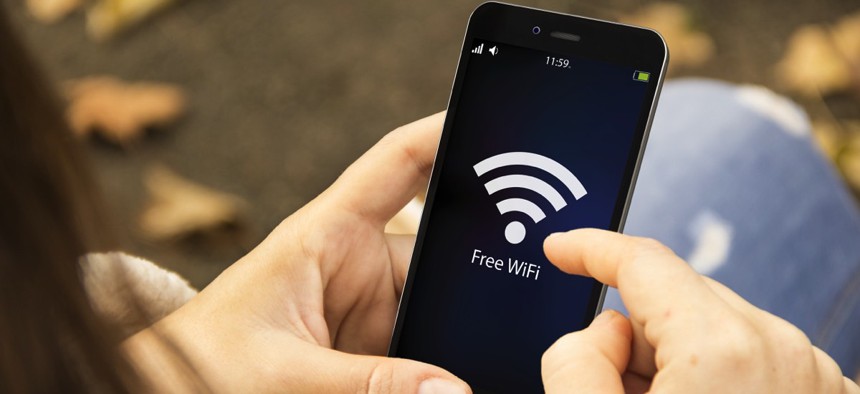Smart Cities Pushing Public Wi-Fi Must Be Mindful of Overcrowding Frequencies

Georgejmclittle / Shutterstock.com
Cell carriers’ new LTE-U technology could further strain broadband’s open spectrum, barring FCC regulation or the establishment of agreed-upon industry standards.
Local governments take for granted all the ways they use Wi-Fi for services, and smart cities driving additional devices and data traffic onto available frequencies could render them sluggish.
A number of cities boast open access hotspots, network parking meters wirelessly and host environmental apps monitoring water safety and air quality.
And the Internet of Things fuels municipal Wi-Fi use exponentially—more and more cities connecting sensors to their networks for performance analysis of their services.
“So it’s not just a matter of devices we use like cellphones and laptops, but it’s devices that are working on our behalf as citizens of a city or town,” said Paul Garnett, Microsoft's director of affordable access initiatives, during a recent Next Century Cities WiFiForward Webinar . “That’s placing a lot of pressure on our existing frequencies, and that’s part of the reason, for example, there’s such interest in getting access to more 5 GHz frequencies that are used for great high-capacity, short-range Wi-Fi applications.”
Certain broadband uses don’t require a license if they operate at a low enough power level and are willing to accept interference from other users, according to the Federal Communication Commission. Such uses, like Wi-Fi and Bluetooth, are part of what’s known as the unlicensed, or open, spectrum.
WiFiForward is a coalition of technology companies like Microsoft and Google raising awareness of the open spectrum’s increased use while advocating for freeing up more frequencies. By 2017, Cisco Systems projects that Wi-Fi devices will account for the majority of Internet traffic.
One solution is the lightly used 5 GHz “growth band” of Wi-Fi frequencies that regulators are starting to make available.
Another possibility is TV White Spaces, frequencies below 700 MHz, within the UHF and VHF bands, the FCC has begun allowing unlicensed access to and Microsoft is promoting. The frequencies are good for long range communications, Garnett said, so a public safety authority could build a network covering a large geographic area with them.
But the FCC’s opening up of more bands might not be able to keep pace with cell carriers that—faced with an explosion of data on their own networks—recently got the go-ahead to test LTE Unlicensed technology.
LTE-U ties licensed and unlicensed frequencies together using a cellphone protocol, but it would introduce new forms of signaling into the open spectrum that testing has shown interfere with Wi-Fi, said Ellen Satterwhite, director of tech advocacy Glen Echo Group.
“LTE-U runs the risk of crowding out existing Wi-Fi applications,” she said—effectively “talking over” other users.
And it’s not a problem your cable company could fix.
Next Century Cities, a nonprofit collaborative of more than 100 communities trying to improve higher-speed Internet connectivity, and WiFiForward argue coexistence might be possible if standards for sharing the open spectrum are established. But one LTE-U backer in particular, Qualcomm, has been unwilling to come to the table for fear its patents might need to be altered.
The FCC hasn’t taken sides, and while it’s shown skepticism of Qualcomm’s motivations, it would be easier for the Wi-Fi and cellular industries to come to their own agreement on standards, said Harold Feld, senior vice president of nonprofit digital advocacy group Public Knowledge.
Frequency overcrowding fears aside, all three panelists’ organizations support bringing broadband to underserved populations with the goal of universal access.
“I just think local governments in particular ought to be supporting these kinds of local initiatives,” Feld said. “They encourage competition. They provide local jobs.”
By partnering with wireless ISPs, cities can ensure low-cost connectivity like New York City has done converting old payphones into public Wi-Fi hotspots, he added, and partnering on a project with public schools in Harlem.
Local initiatives also bring small businesses into play.
“Local governments can look at the assets they have in the ground now—whether it is fiber that they have for other purposes, whether it is a budget designed to do things like foster connectivity,” Feld said, “And can say, ‘We really ought to look at whether there is a way to leverage [them].’”
Dave Nyczepir is a News Editor at Government Executive’s Route Fifty.
NEXT STORY: These Metro Areas Had the Lowest Rental Housing Vacancy Rates at the End of Last Year






